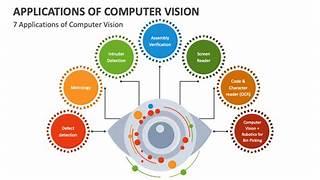Computer Vision and Image Understanding: Advanced Techniques and Applications
In the modern digital age, the realm of computer vision has grown to be a key pillar of artificial intelligence (AI). The task of enabling machines to see, interpret, and make decisions based on visual inputs has vast implications across industries, from autonomous vehicles to medical imaging. The field of computer vision is centered on the development of techniques that allow machines to interpret and understand the world through visual data. This article will explore the advanced techniques and applications of computer vision, shedding light on its current state and future prospects.
Understanding Computer Vision
At its core, computer vision aims to replicate the human ability to understand and process images and videos. Human vision is a complex and sophisticated process that includes multiple stages, such as image acquisition, pre-processing, object recognition, and decision-making. Similarly, computer vision employs algorithms that allow machines to “see” and understand images.
A critical component of computer vision is image understanding, where machines not only detect objects in images but also interpret and categorize them in ways that enable more complex tasks. The challenge lies in creating algorithms that can generalize across different contexts, light conditions, and environments while also dealing with large volumes of visual data.
Advanced Techniques in Computer Vision
- Deep Learning and Convolutional Neural Networks (CNNs)
Over the past decade, deep learning has revolutionized computer vision. Traditional machine learning techniques required handcrafted features, where the user manually defined relevant aspects of images. However, deep learning, specifically Convolutional Neural Networks (CNNs), has automated this process. CNNs can automatically learn hierarchical features from raw image pixels, significantly improving the accuracy and efficiency of image classification, object detection, and segmentation.
CNNs are designed to mimic the visual processing mechanisms in the human brain, employing layers of convolutional and pooling operations to detect low-level features (like edges and textures) and then combine them into higher-level concepts (such as faces or specific objects).
- Object Detection and Recognition
One of the most powerful aspects of computer vision is object detection, where the system identifies and locates specific objects within an image. Object recognition goes a step further by classifying the object once it has been detected. Advanced algorithms like YOLO (You Only Look Once) and Faster R-CNN have made significant strides in improving the speed and accuracy of object detection.
These systems are often used in applications like self-driving cars, where the vehicle must detect pedestrians, traffic signs, and other vehicles to make safe decisions in real time. The integration of object detection with facial recognition also plays a crucial role in security and surveillance systems.
- Image Segmentation
Image segmentation refers to the process of dividing an image into meaningful parts or segments. Each segment represents a distinct object or region within the image. This technique is particularly useful when precise details are necessary, such as medical imaging, where understanding the boundaries of a tumor can be crucial for diagnosis.
Advanced segmentation techniques such as Mask R-CNN combine object detection and segmentation to create more accurate predictions. These systems identify not only what objects are present but also provide pixel-level details about the shape and extent of the object.
- Generative Adversarial Networks (GANs)
Generative Adversarial Networks (GANs) are an exciting innovation in computer vision. GANs consist of two neural networks—a generator and a discriminator—that work in opposition to each other. The generator creates fake images, while the discriminator attempts to distinguish between real and fake images. Over time, the generator learns to produce highly realistic images that are indistinguishable from real ones.
GANs are used in several advanced computer vision applications, including image super-resolution, style transfer, and even video generation. The ability to generate realistic images and videos has opened up new opportunities in creative fields such as art and entertainment.
- 3D Vision and Depth Perception
While 2D image understanding has been the foundation of computer vision, recent advancements have enabled machines to understand depth and spatial relationships in 3D environments. Technologies like stereo vision, LiDAR (Light Detection and Ranging), and structured light enable machines to perceive depth, making them capable of interpreting complex scenes in three dimensions.
This 3D vision is crucial for applications in robotics, augmented reality (AR), and autonomous vehicles, where the understanding of the environment in three-dimensional space is essential for navigation and interaction.
- Optical Flow and Motion Analysis
Optical flow refers to the pattern of motion of objects in a visual scene. It is used to estimate the movement of objects between consecutive frames in a video sequence. Optical flow techniques are often combined with other methods such as object detection to track the motion of moving objects in real time.
Motion analysis has several applications, including video surveillance, sports analysis, and human-computer interaction. By tracking the movements of individuals or objects, computer vision systems can provide real-time feedback, detect anomalies, or predict future actions.
- Self-supervised Learning and Transfer Learning
One of the challenges in computer vision is the requirement for large amounts of labeled data for training models. Labeling images manually is both time-consuming and expensive. To address this, self-supervised learning has emerged as a promising approach, where a model learns to understand the structure of data without needing explicit labels. The model generates its own supervisory signals by making use of the inherent patterns in the data.
Transfer learning, on the other hand, involves taking a pre-trained model (often trained on a large dataset like ImageNet) and fine-tuning it for a specific task. This allows models to achieve high accuracy even with limited labeled data.
Applications of Computer Vision
- Healthcare and Medical Imaging
One of the most impactful applications of computer vision is in healthcare. In medical imaging, computer vision systems can assist in diagnosing diseases by analyzing X-rays, MRIs, and CT scans. Advanced algorithms can detect anomalies such as tumors, fractures, or heart conditions that might be missed by human doctors.
In recent years, deep learning models have demonstrated impressive performance in fields like radiology, pathology, and ophthalmology. AI models trained on large datasets of medical images can help doctors provide faster and more accurate diagnoses, ultimately improving patient outcomes.
- Autonomous Vehicles
Self-driving cars represent one of the most high-profile applications of computer vision. These vehicles rely on computer vision systems to interpret the surrounding environment in real-time. Using cameras, LiDAR, and radar, the car’s vision system must identify objects, detect road signs, recognize lane markings, and predict the movements of pedestrians and other vehicles.
The ability of a self-driving car to navigate complex environments safely relies on the real-time processing of large amounts of visual data, making computer vision an essential technology for autonomous driving.
- Agriculture and Environmental Monitoring
Computer vision is increasingly being used in precision agriculture, where it helps monitor crop health, detect pests, and optimize irrigation. Drones equipped with cameras can capture aerial images of large farmlands, and computer vision algorithms can analyze these images to assess the health of crops or identify potential problems before they become widespread.
In environmental monitoring, computer vision systems can be used to track deforestation, monitor wildlife, and even analyze the impact of climate change. By automating the analysis of satellite or drone imagery, these systems provide timely insights that help in decision-making processes related to conservation and resource management.
- Retail and E-commerce
Computer vision is transforming the retail industry through innovations like cashier-less stores, where customers can shop and simply walk out without having to go through a traditional checkout process. Using cameras and computer vision algorithms, these stores can track what products customers pick up and automatically charge them for their purchases.
Additionally, computer vision is being used for inventory management, where systems can scan shelves in stores to ensure that stock levels are adequate. For e-commerce, computer vision allows for more accurate product recommendations by analyzing images of products and matching them with customer preferences.
- Security and Surveillance
Surveillance systems powered by computer vision are used for monitoring public spaces, detecting security threats, and identifying individuals in crowds. Facial recognition technology, in particular, has gained widespread attention for its ability to match faces from live video feeds with databases of known individuals.
These systems are being deployed in airports, train stations, and other high-security locations to enhance safety. While they raise privacy concerns, they offer significant potential in terms of identifying criminals, tracking lost persons, and preventing crimes before they occur.
Conclusion
The field of computer vision is at the forefront of technological advancement, enabling machines to perceive and understand the world as humans do. Through deep learning, object detection, image segmentation, and other cutting-edge techniques, computer vision has achieved remarkable progress in areas like healthcare, autonomous vehicles, and retail. As AI continues to evolve, the applications of computer vision are only expected to grow, opening up new possibilities for automation, innovation, and efficiency in virtually every industry.
The future of computer vision promises even more sophisticated and powerful systems that will continue to push the boundaries of what machines can see and understand. Whether it’s helping doctors diagnose diseases, enabling safer autonomous vehicles, or transforming industries like agriculture and retail, the impact of computer vision will be felt across the globe for years to come.


